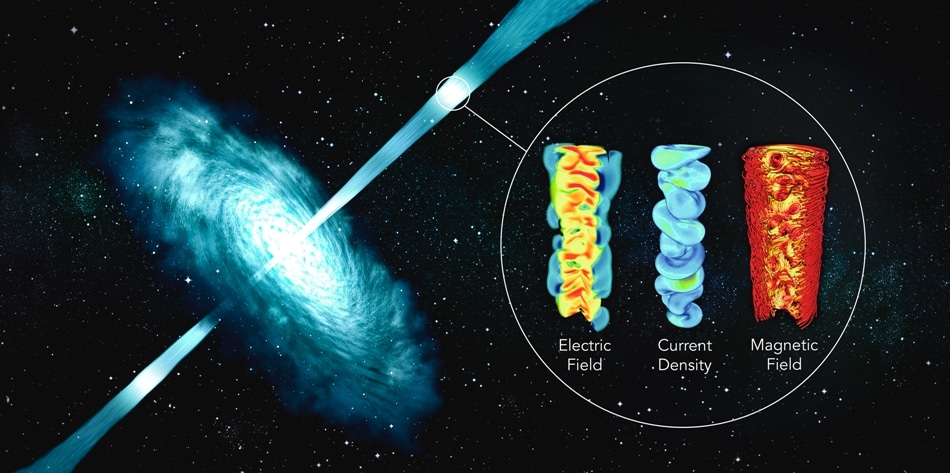Dec 14 2018
Magnetic field lines, twisted like spaghetti in a bowl, could possibly be behind the most robust particle accelerators existing in the universe.
 SLAC researchers have found a new mechanism that could explain how plasma jets emerging from the center of active galaxies, like the one shown in this illustration, accelerate particles to extreme energies. Computer simulations (circled area) showed that tangled magnetic field lines create strong electric fields in the direction of the jets, leading to dense electric currents of high-energy particles streaming away from the galaxy. (Image credit: Greg Stewart/SLAC National Accelerator Laboratory)
SLAC researchers have found a new mechanism that could explain how plasma jets emerging from the center of active galaxies, like the one shown in this illustration, accelerate particles to extreme energies. Computer simulations (circled area) showed that tangled magnetic field lines create strong electric fields in the direction of the jets, leading to dense electric currents of high-energy particles streaming away from the galaxy. (Image credit: Greg Stewart/SLAC National Accelerator Laboratory)
That is the outcome of the latest computational study performed by scientists from the Department of Energy’s SLAC National Accelerator Laboratory, which replicated particle emissions from remote active galaxies.
Supermassive black holes, at the hub of these distant active galaxies, launch high-speed jets of a hot, ionized gas—plasma—shooting innumerable light years into space. Such a process might possibly be the source of cosmic rays that have energies tens of millions of times greater than the energy released in the most robust particle accelerator made by man.
The mechanism that creates these extreme particle energies isn’t known yet. But based on our simulations, we’re able to propose a new mechanism that can potentially explain how these cosmic particle accelerators work.
Frederico Fiúza, Scientist, SLAC National Accelerator Laboratory.
Fiúzais is also the principal investigator of a new study that has been published in Physical Review Letters.
Moreover, the outcomes may have implications for studies related to plasma and nuclear fusion as well as the development of new high-energy particle accelerators.
Simulating cosmic jets
The aggressive processes that increase the cosmic particles’ energy have fascinated scientists for a long time. For instance, scientists collected proof that shock waves resulting from strong star explosions could speed up particles and send them across the universe.
Furthermore, researchers have indicated that magnetic energy could be the primary force for cosmic plasma jets. This magnetic energy is discharged when magnetic field lines in plasmas break and connect again in a different manner—a process called “magnetic reconnection.”
Yet, the latest research indicates an entirely different mechanism that is associated with the disruption of the helical magnetic field produced by the supermassive black hole rotating at the middle of active galaxies.
“We knew that these fields can become unstable,” stated Paulo Alves, lead author and a research associate working with Fiúza. “But what exactly happens when the magnetic fields become distorted, and could this process explain how particles gain tremendous energy in these jets? That’s what we wanted to find out in our study.”
To do so, the investigators replicated the motions of around 550 billion particles—a tiny version of a cosmic jet—on the Mira supercomputer installed at the Argonne Leadership Computing Facility (ALCF) at DOE’s Argonne National Laboratory. Following this, the researchers scaled up their results to cosmic dimensions and evaluated them against astrophysical observations.
From tangled field lines to high-energy particles
The simulations revealed that strong distortion of the helical magnetic field caused the magnetic field lines to become highly twisted and a huge electric field is generated inside the jet. Obviously, such an arrangement of magnetic and electric fields can effectively speed up protons and electrons to extreme energies. Although high-energy electrons are able to radiate their energy away in the form of gamma rays and X-rays, protons can dodge the jet into space and reach the atmosphere of the Earth as cosmic radiation.
“We see that a large portion of the magnetic energy released in the process goes into high-energy particles, and the acceleration mechanism can explain both the high-energy radiation coming from active galaxies and the highest cosmic-ray energies observed,” said Alves.
Roger Blandford, former director of the SLAC/Stanford University Kavli Institute for Particle Astrophysics and Cosmology (KIPAC) and an expert in black hole physics, stated, “This careful analysis identifies many surprising details of what happens under conditions thought to be present in distant jets, and may help explain some remarkable astrophysical observations.” Blandford was not involved in the work.
Next, the investigators intend to link their work even more strongly with real observations, for instance, by investigating what makes the radiation emitted from cosmic jets to differ quickly over time. The team is also planning to do laboratory studies to establish if the same mechanism suggested in this work could also promote particle acceleration and disruptions in fusion plasmas.
The study was also co-authored by Jonathan Zrake, a former Kavli Fellow at KIPAC, who is now at Columbia University. The project was supported by the DOE Office of Science via its Early Career Research Program and an ALCC award for simulations on the Mira high-performance computer. ALCF is a DOE Office of Science user facility.
Cosmic Jet Simulations
These movies show how distortions of the helical magnetic field of a cosmic jet (center) generate a strong electric field in the jet direction (left). The electric field boosts the energy of charged particles, effectively creating a dense electric current along the jet (right). (Video credit: SLAC National Accelerator Laboratory)